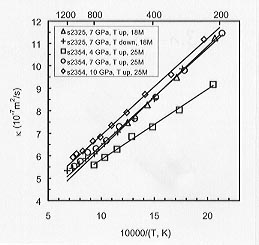

It is well known that a knowledge of heat-transport properties of olivine and its high-pressure polymorphs is essential for understanding thermal regimes in the Earth's mantle, especially in subduction zones. The thermal diffusivity and conductivity of olivine have been measured at ambient and high pressures. However, thermal diffusivities and conductivities of the higher pressure polymorphs wadsleyite and ringwoodite are not known. We have therefore developed a technique to perform these measurements in a multianvil apparatus. We have now obtained data for olivine and plan to extend the measurements to wadsleyite and ringwoodite.
We modified the periodic temperature wave method (Angström's Method) for application to cylindrical samples in 18M and 25M assemblies in a 6-8 type multianvil apparatus. A stepped heater was used to produce homogeneous temperatures through out the sample. In addition, ZrO2 cylinders were placed at both ends of the sample to reduce heat flow along the axial direction. In order to reduce geometric distortion of the sample, the cylindrical sample was first sintered in a previous experiment and then a hole with a 0.3 mm diameter was drilled along the axis of the sample to accommodate the inner thermocouple. A groove was also made at the outer surface of the sample in the axial direction to accommodate the outer thermocouple. WRe3/WRe25 thermocouples with 0.076 mm diameter wires were used to reduce loss of Fe from the Fe-bearing sample.
An alternating current at 1 kHz was supplied to the furnace for heating to the desired temperature. To generate a sinusoidal temperature, a sine wave variation with a period in the range 0.77-1.0 sec modulated the heater current. The temperature variations detected by the two thermocouples were recorded on a computer; we obtained the amplitude ratio and phase lag by computing the fitted parameters of the two sinusoidal temperature waves. Because the heating element is on the surface of the cylinder and therefore has a large radiation surface, the net heat transfer by direct radiation becomes appreciable for transparent materials at high temperature, an effect that is probably larger for amplitude than for phase.
In order to determine the reproducibility of the method, two different multianvil assemblies, having sample diameters of 2.5 mm (run s2325) and 3.7 mm (run s2354) respectively, were used to determine the thermal diffusivity of polycrystalline San Carlos olivine. Figure 3.1-11 shows thermal diffusivity vs. reciprocal temperature at different pressures. In run s2325 we measured the thermal diffusivity in an 18M assembly at 7 GPa and temperatures from 25 to 520°C. Then we increased the temperature directly to 1200°C and kept it at 1200°C for 30 minutes. Thermal diffusivity at 1200°C changed little in 30 minutes and the results obtained on reducing the temperature are consistent with those obtained during heating (Fig. 3.1-11). Another experiment was performed at three different pressures in a 25M assembly. The thermal diffusivity obtained at 7 GPa in the 25M assembly is consistent with that obtained in the smaller 18M assembly (Fig. 3.1-11). Obtaining the same result in different configurations satisfies the important criterion of reproducibility.
 |
Fig. 3.1-11: Thermal diffusivity of olivine vs. reciprocal temperature.
|
The results show that the thermal diffusivity is proportional to reciprocal temperature between 200 and 800°C, which indicates that lattice conduction represents the main contribution to the bulk thermal diffusivity. The thermal diffusivity deviates from a linear relationship with reciprocal temperature to higher values above 800°C. In order to determine if radiative conduction contributed to the bulk thermal diffusivity, we computed the residual thermal diffusivity from the bulk thermal diffusivity minus the lattice thermal diffusivity for run s2325. The results show that the residual thermal diffusivity is proportional to T3 above 800°C and therefore indicate that radiative conduction does contribute to the bulk thermal diffusivity.

Tel: +49-(0) 921 55 3700 / 3766, Fax: +49-(0) 921 55 3769, E-mail: bayerisches.geoinstitut(at)uni-bayreuth.de
 Previous page
Previous page